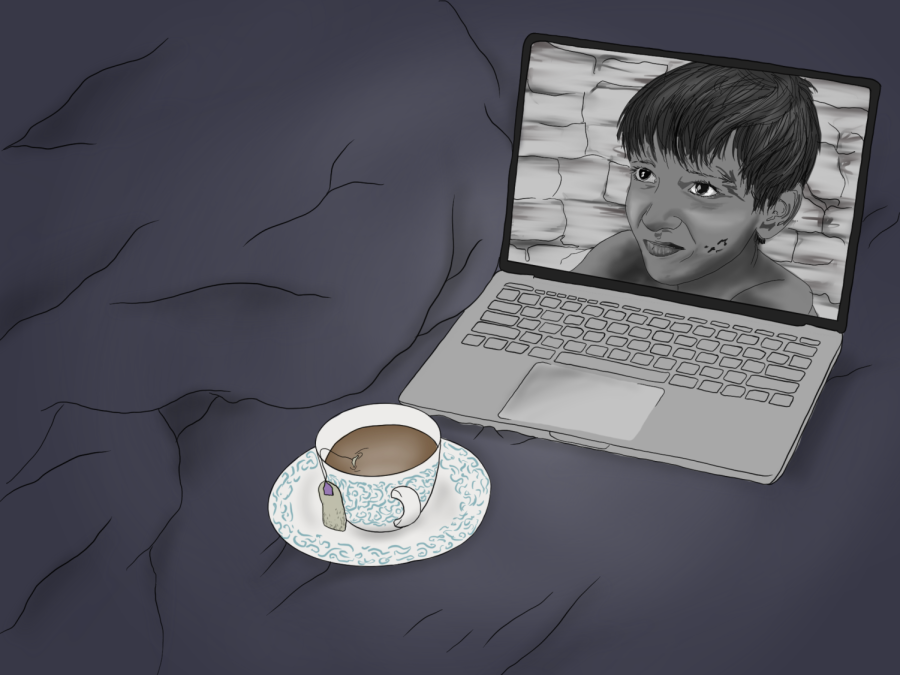Off the Radar: ‘Pather Panchali,’ the poetic low-budget film that put Indian cinema on the map
“Off the Radar” is a weekly column surveying overlooked films available to students for free via NYU’s streaming partnerships. “Pather Panchali” is available to stream on NYU Stream.
Satyajit Ray’s 1955 film “Pather Panchali” is about a family living in a rural Bengali village. The film is available for free via NYU’s streaming partnerships. (Staff Illustration by Aaliya Luthra)
March 11, 2022
With a technical crew of first-timers, Satyajit Ray’s debut film “Pather Panchali” (1955) became the first internationally critically acclaimed Indian film. Its success is a story in itself: Ray’s wife pawned her jewels and Ray sold his life insurance policy to fund the film’s production. The film ran out of money anyway, causing shoots to be delayed. Ray was only able to finish the film with the little money he had left over because Apu’s voice remained childlike, Durga looked the same, and the aunt character, Indir Thakrun, didn’t die over the course of the extended production. The success of “Pather Panchali” — which won the Best Human Document at the 1956 Cannes festival — allowed for a trilogy to be created under the same lore: “Aparajito” (1956) and “The World of Apu” (1959).
This film tells the story of a family living in a rural Bengali village. The father, Harihar (Kanu Banerjee), is a priest obsessed with finding success in writing. His passive attitude toward money drives the mother, Sarbojaya (Karuna Banerjee), to brood over the looming threat of poverty. With her older daughter, Durga (Runki Banerjee), and younger son, Apu (Subir Banerjee), the family navigates their daily lives in hopes of a better tomorrow. Together, they have to care for their aging aunt, withstand gossiping neighbors and prepare for an imminent monsoon.
Satyajit Ray plays with idle time in “Pather Panchali.” We join Apu and Durga for runs around the village, from dense forests with small pathways to fields where the children chase the occasional passing train. The real time we spend with them creates a hyperrealistic perspective.
Ray does not shy away from the characters’ surroundings. We see the family’s dilapidated house as it is. We witness the frustration of Sarbojaya bubbling up, with the pressure of motherhood mounting as she experiences crushing loneliness while her husband looks for work outside of their village. We become fully immersed in the world we idle in with these characters. It almost feels like we are witnessing Ray’s India through a documentary at times.
The intimate nature of the characters’ depictions heightens the empathy we feel, like when we witness Durga and Apu’s fight after Apu steals tinsel from Durga’s toy box. The fight is short-lived, ending in a chase that leads Durga and Apu to witness a train passing together. The tenderness is palpable, inviting us into these characters’ compassionate patterns.
The film shifts viewpoints from Durga as a young child, to Apu as a young child. These viewpoints are crucial to understanding Ray’s intention in the film. The children’s playful attitude is contrasted against the grim reality of their living conditions. Ray ensures we observe a lot of play — kids being kids. It speaks to the resilience of children and their universal instinct for creating joy. It also speaks to the idle condition of these kids — walking without any real direction and playing without any true sense of purpose — reflects how little influence they have over their surroundings. This parallels the very little control the adults have over the nature of the world.
Contentment and sorrow level out, allowing for the poetic truth of life to seep through. The resilience we witness from the characters is framed by reality. Ray minimizes the use of any jarring cinematic devices and allows the story to breathe. We see this through the abundance of nature as well. Nature is uncontrolled, similar to a child’s temperament.
The nuances of this tale’s subject matter is astounding, as it seems to be at times a reflection of self. Sarbojaya’s fear of not being able to feed her children transforms her into a woman who is snappy and impatient but justified. Durga’s habit of stealing fruit from her neighbor’s orchard, despite being scolded by her mother, is at its core a habit of gift-giving to her beloved aunt and Apu. Harihar’s optimism and refusal to leave their ancestral home despite their conditions are both admirable and questionable. The audience is left to wonder whether they can fully blame any of these characters for their dispositions. These characters’ complexities allow us ot live in gray — nobody is solely black or white.
“Pather Panchali” is a sliver of human experience, a conglomeration of the lives, beliefs and persistence the world holds. Ray encapsulates this in his poetics, leaving you in a meditative state. The struggle for the film’s completion speaks to Ray’s belief in the resilience of the human spirit. “Pather Panchali” is a careful composition of the human condition, transcending borders.
If you want to feel the most human, on a ride of contentment and sorrow, and ultimately to fill your soul, “Pather Panchali” is a must-see. Prepare for the rise and fall of the painful beauty of the human condition.
You can view “Pather Panchali” for free on NYU Stream. In addition, you can complete the trilogy with “Aparajito” (1956) and “The World of Apu” (1959).
Contact Amira Aboudallah at [email protected].
























































































































































